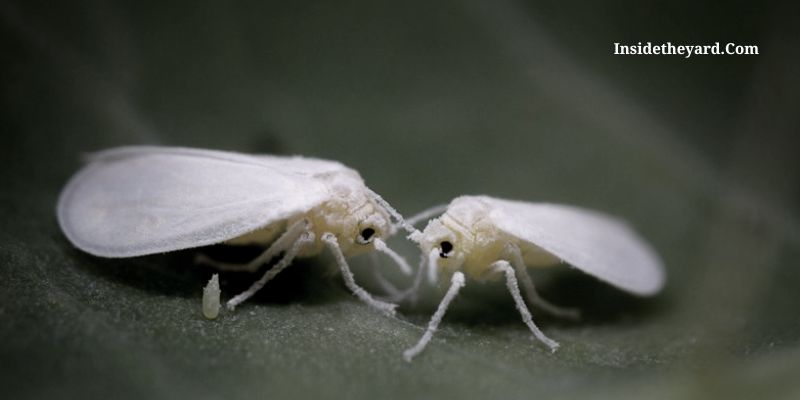Whiteflies Life Cycle- [Phases, Damages Caused, How To Prevent And Eliminate]
It may strike your mind why knowing the Whiteflies life cycle is essential. It is essential to take preventive measures and control infestation in your garden or farm.
Like every other insect, Whiteflies also have multiple stage-wise life cycles. And it causes damage to the plants in most stages of the life cycle.
You should understand the Whiteflies Life Cycle for infestation control in your garden or crop field. Go through the article till the end to learn more about the lifecycle stages and damage control procedures.
Table of Contents
Whiteflies Life Cycle

Whiteflies do not belong to a fly family. Instead, it’s a moth-like bug from the order Hemiptera and Family Aleyrodidae.Along with the adult Whiteflies, other different stages also cause harm to the leaves.
There are Two Major Species of whiteflies, namely the Greenhouse Whitefly or Trialeurodes vaporariorum and the Tobacco Whitefly or Bemisia tabaci.
Among these, the Greenhouse whiteflies are more common and dangerous. The mating and egg-laying season for the whiteflies starts in late Spring.
Stage 1: Adults Laying Eggs
In the first stage, adult females start to lay eggs on the underside of the young leaves of a plant. It generally chooses the vegetative and ornamental plants as the host for laying eggs.
Mostly male Whiteflies are produced if the mother white has not mated. You can identify the eggs by looking at the White-Yellowish shade. The eggs get attached to the leaves in a circular or arc shape by the secretion from the Whitefly. Around 51-100 Whitefly eggs are secreted at a time.
You will observe that the eggs turn darker in one or two days. It is an indication that eggs will pass through the second stage of the life cycle.
Stage 2: Crawlers or First Instar
The crawlers are mostly transparent in color, and the yellowish internal sight can be seen. They move on the leaves for some time and then settle on the underside of the leaves. This immobilization is done to feed on the leaves.
That is why this is the time you should become alert because it takes very little time to turn a nymph into a full-sized adult. If you want to control the high-density infestation, this stage is the right time.
Stage 3: Second Instars
In this stage, the nymphs are completely immobilized and remain stuck to the underside of the leaves. It starts to feed on the sap of the leaves. Besides, honeydews start to develop within the internal organs of the Nymph.
Stage 4: Third Instars
The nymphs of the Whiteflies follow three Nymphal exuviates or skin shedding. The nymph grows in size during all these stages by constant feeding on the leaf sap.
Stage 5: Third Instar or Pupa Stage
After the final skin shedding, the pupa is released from the Nymphal cover. The shape is flat and round at first, followed by an Oval-box-shaped Pupa with hairs on the body.
The pupa gets released in 11 days in Summer and 31 days in the summer. Therefore you will get enough time to stop the life cycle and thus the infestation by taking control measures.
Stage 6: Releasing Adult Whiteflies
In the final stage, the adult Whitefly emerges by shedding the skin from the Pupa stage. After being released, it slowly extends the folded wings. Another identification to detect the Whiteflies in the Secretion of Wax in the adults.
The adult Whiteflies immediately start to feed on the sap of the leaves from the veins. It happens in greater volume than the Nymph stages. Therefore the leaves start to die soon after.
This whitefly life cycle takes around 17 to 25 35 days to complete depending upon the region’s temperature. The process becomes slow in winter and accelerates in the summer.
An adult Whitefly soon starts to mate with the opposite gender. Moreover, it can live for 30 days. As a result, few more generations of Whiteflies can be developed if not prevented on time.
Whitefly Damage Symptoms
Some primary and secondary symptoms will allow you to identify a Whitefly infestation.
Whiteflies Damage Control And Prevention
If you can manage to prevent the infestation at an early stage, you can stop the growth of the Whitefly colony. Besides, you can save your crops and ornamental leaves from getting destroyed or, even worse, dying.
Natural Control System
There is a wide range of Entomophagus insects, parasites, and entomopathogenic fungi. These are beneficial and less harmful for the plants.
Insects such as Ladybugs, dragonflies, beetles, green lacewings, whitefly parasite wasps, etc., are called natural predators of the whiteflies. These feed on the eggs and pupa of the whiteflies.
Farming Control System
It is beneficial to remove the infected leaves or weeds by cutting off the branch. Isolate the plants after the recovery treatment and avoid an infestation in nearby plants.
You can also use a net, barrier, and covering for the healthy plants to avoid being infected by the whiteflies. Regularly spraying the plants, especially the infested areas, with high-flow water is also a good preventive action.
The Yellow color attracts whiteflies, so egg-laying whiteflies get stuck on the sticky traps if kept near the leaves.
Chemically Extermination Method
You can use a diluted with a sufficient amount of water Bifenthrin 10% EC, Dimethoate 30% EC, and Dinotefuran 20% SG.
Spray these insecticide solutions regularly to keep them safe from Whitefly infestation.
This Video Will Help You Too!
Frequently Asked Questions (FAQs)
Which disease is transmitted by Whitefly?
Whiteflies are responsible for spreading the TYMV, otherwise known as Yellow Mosaic viruses, to crops and vegetative plants. It also transmits Gemini and Chlorosis virus causing TYLCV and TOCV disease.
What is the lifespan of whitefly?
On different average, species of Whiteflies have a longevity of 30 to 40 days. The lifespan is dependent upon the environmental temperature. A lower temperature reduces the lifespan, whereas a high temperature increases the lifespan.
What is the best way to get rid of whiteflies?
The best way to get rid of whiteflies is to use insecticides and pesticides. Using natural predators to kill whiteflies can be fruitful but time-consuming. Using nets, sticky traps, and cutting off the infested leaves followed by regular inspection may give a healthy and sustainable result.
Are whiteflies harmful to humans?
Whiteflies are not directly harmful to humans as they do not bite or carry viruses against humans. But, they can cause indirect harm to humans by infesting vegetative plants such as Tomato and peas. Consuming infested vegetables are not suitable for humans.
Do whiteflies affect humans?
Whiteflies do not bite humans or transmit virus-borne diseases to humans. Hence, Whiteflies cannot affect humans as long as humans do not consume the infected plants. But it can affect humans economically as the whitefly infestation kills the vegetative plants and crops.
Conclusion
Now that you have learned about the symptoms, damage, and preventative measures, you can keep your plants safe from an infestation.
It can be annoying to find your favorite ornamental plants and vegetative crops attacked by the Whiteflies.
Knowing the whiteflies life cycle can be beneficial for you to take early steps and stop the whitefly infestation after proper identification.
Prevention from the infestation is more beneficial for plants and your budget than curing the plant afterward.
’






